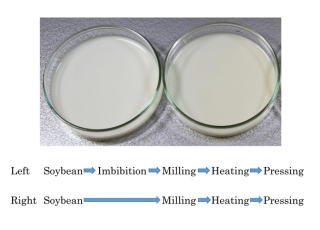Food Engineering

- account_circleMakoto ShimoyamadaPhD, Prof.
- account_circleKazuya MurakamiPhD, Research Asst. Prof.
- Website:https://dfns.u-shizuoka-ken.ac.jp/labs/mfe/
- Mail:shimoyam@u-shizuoka-ken.ac.jp
- Phone:+81-54-264-5522
Clarifying Food Processing from a Molecular Aspect
Structural Changes of Food Constituents through Processing and Functionality of Food Derived from Interactions
- 1. Denaturation behavior of food proteins using thermal treatment
In food processing, food materials are repeatedly heated and cooled. To determine the effect of complex heating, soymilk was heated using one- or two-step heating at different temperatures and heating rates. Characterization of the resulting soymilk (viscosity, protein denaturation rate, changes in higher structures, protein aggregation, etc.) demonstrated a relationship between heating conditions and protein denaturation, providing information to potentially improve the quality of the products.
- 2. Improvement of soymilk beverage processing
Soymilk beverage processing methods are based purely on empirical data, thus there is very limited scientific data. Using chemical and engineering approaches, the processing could be improved and soymilk quality would become higher. Currently, milling temperature and bean soaking are determined from protein denaturation and dispersion stability.
- Figure 1
- Heating conditions affect thermal denaturation of protein, resulting in improved quality of proteineous food

- Figure 2
- Omission of imbibition in soymilk processing had little effect on the character of the soymilk (appearance, protein content, acceptability, etc.)

References
- LWT-Food Sci. Technol., 112, 108255 (2019)
- Food Sci. Technol. Res., 24, 355-361 (2018)
- Food Sci. Technol. Res., 21, 439-444 (2015)
- Food Chemistry, 140, 39-43 (2013)